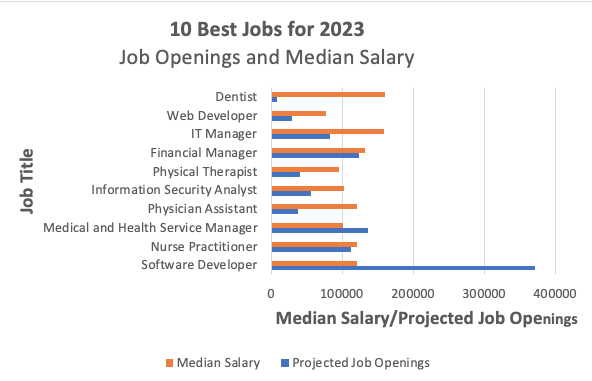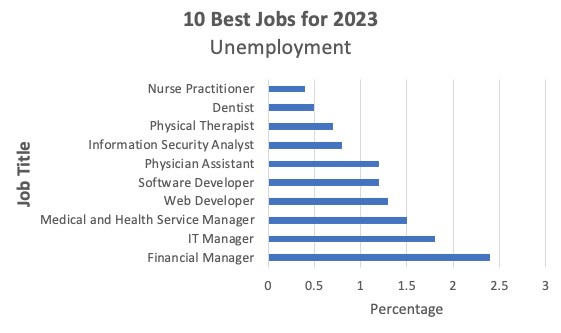U.S. News and World Report recently published their 100 Best Jobs of 2023 report. To come up with the list, they compiled data from the Bureau of Labor Statistics and selected the seven elements below that they felt were the most important when looking for a job.
Job Report Criteria
Each element was assigned a value from 0 to 10 based on the criteria used for each element.
1. Median Salary
To come up with the median salary value, they took the square root of the median salary for a specific job and divided it by four and set a maximum assigned value of 10 points. The higher the salary, the higher the value.
2. Unemployment Rate
The assigned value for this element was a direct translation of the unemployment rate to a point value. For example, if a job had an unemployment rate of less than 0.8%, it received a full 10 points; however a job with an unemployment rate of 3.3% only received 2 points.
3. 10-Year Growth Volume
For this element, a job with a projected growth rate of 85,000 openings or more received a full 10 points, while a job that will only have 1,000 openings or less received 2 points.
4. 10-Year Growth Percentage
The value for this element uses the same methodology as the previous element, except it uses a percentage instead of a hard number. A job with a 25% or greater growth received a full 10 points, while jobs with less than a 4% projected growth only received two points.
5. Future Job Prospects
Points assigned for this element are based on the job’s descriptive rate. A job rated “excellent” received a full 10 points; one with a rating of “keen competition” received only two points.
6. Stress Level
A job having a stress level of “high” received two points, whereas a job with a stress level of “low” received the full 10 points.
7. Work/Life Balance
Similar to the stress level element, points were assigned due to the qualitative ratings. A “high” rating received 10 points, but a “low” rating only received two points.
10 Best Jobs
As mentioned before, the complete report has the top 100 jobs listed; from data in the report, here are the top 10 jobs:
1. Software Developer
- Projected Job Openings: 370,600
- Unemployment Rate: 1.2%
- Median Salary: $120,730
- Education Required: Bachelor’s Degree
2. Nurse Practitioner
- Projected Job Openings: 112,700
- Unemployment Rate: 0.4%
- Median Salary: $120,680
- Education Required: Master’s Degree
3. Medical and Health Service Manager
- Projected Job Openings: 136,200
- Unemployment Rate: 1.5%
- Median Salary: $101,340
- Education Required: Bachelor’s Degree
4. Physician Assistant
- Projected Job Openings: 38,400
- Unemployment Rate: 1.2%
- Median Salary: $121,530
- Education Required: Master’s Degree
5. Information Security Analyst
- Projected Job Openings: 56,500
- Unemployment Rate: 0.8%
- Median Salary: $102,600
- Education Required: Bachelor’s Degree
6. Physical Therapist
- Projected Job Openings: 40,400
- Unemployment Rate: 0.7%
- Median Salary: $95,620
- Education Required: Doctorate Degree
7. Financial Manager
- Projected Job Openings: 123,100
- Unemployment Rate: 2.4%
- Median Salary: $131,710
- Education Required: Bachelor’s Degree
8. IT Manager
- Projected Job Openings: 82,400
- Unemployment Rate: 1.8%
- Median Salary: $159,010
- Education Required: Bachelor’s Degree
9. Web Developer
- Projected Job Openings: 28,900
- Unemployment Rate: 1.3%
- Median Salary: $77,030
- Education Required: Bachelor’s Degree
10. Dentist
- Projected Job Openings: 7,700
- Unemployment Rate: 0.5%
- Median Salary: $160,370
- Education Required: Doctorate Degree
Comparison Data
In looking at the first chart below, we see that last three jobs all have median salaries over $100,000 per year and over 100,000 projected job openings during the next 10 years. Plus, in the second chart, those same three jobs have an unemployment rate of 1.5% or less, making these three jobs the best choices when comparing just the three factors of unemployment, median salary and projected job openings.
Making the Best Military Transition
For military members getting out in the next few years, now is the time to start thinking about – and preparing for – what you want to do when you get out. If you need more post-secondary education to better position yourself in a specific job market, use Tuition Assistance, Tuition Top-Up while still in and the GI Bill once out to help pay for that additional education.
If you are undecided on a career path, use the information in the 100 Best Jobs for 2023 to help select a field. Then start preparing to meet the entrance requirements for that field by selecting a school that teaches the type and level of degree you need. You have an opportunity to “get ahead of the pack”, but only if you use this time and resources available wisely.






